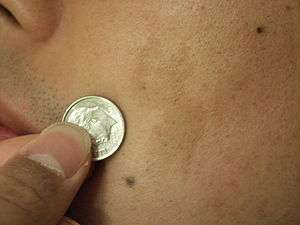Café au lait spot
| Café au lait spot | |
|---|---|
 | |
| A café au lait spot on a patient's left cheek. | |
| Classification and external resources | |
| Specialty | dermatology |
| ICD-10 | L81.3 |
| ICD-9-CM | 709.09 |
| OMIM | 114030 |
| DiseasesDB | 16118 |
| eMedicine | ped/2754 |
| MeSH | D019080 |
Café au lait spots or café au lait macules are flat, pigmented birthmarks.[1] The name café au lait is French for "coffee with milk" and refers to their light-brown color. They are also called "giraffe spots" or "coast of Maine spots".[2]
They are caused by a collection of pigment-producing melanocytes in the epidermis of the skin.[3]
These spots are typically permanent, and may grow or increase in number over time.[4]
Café au lait spots are often harmless, but may be associated with syndromes such as Neurofibromatosis Type 1 and McCune-Albright syndrome.[4]
Etiology

Café au lait spots can arise from diverse and unrelated causes:[5][6]
- Having six or more café au lait spots greater than 5 mm in diameter before puberty, or greater than 15 mm in diameter after puberty, is a diagnostic feature of neurofibromatosis type I, but other features are required to diagnose NF-1.[3]
- Familial multiple café au lait spots have been observed without NF-1 diagnosis.[7]
- They can be caused by vitiligo in the rare McCune–Albright syndrome.[8]
- Legius syndrome
- Tuberous sclerosis
- Fanconi anemia
- Idiopathic
- Ataxia-telangiectasia
- Basal cell nevus syndrome
- Benign congenital skin lesion
- Bloom syndrome
- Chediak-Higashi syndrome
- Congenital naevus
- Gaucher disease
- Hunter syndrome
- Jaffe-Campanacci syndrome
- Maffucci syndrome
- Multiple mucosal neuroma syndrome
- Noonan syndrome
- Pulmonary Stenosis
- Silver–Russell syndrome
- Watson syndrome
- Wiskott–Aldrich syndrome
Diagnosis
Diagnosis is visual with measurement of spot size. The number of spots can have clinical significance for diagnosis of associated disorders such as Neurofibromatosis type I. Greater than or equal to 6 spots of at least 5mm in diameter in pre-pubertal children and at least 15mm in post-pubertal individuals is one of the major diagnostic criteria for NF1.[9]
Prognosis
Café au lait spots are usually present at birth, permanent, and may grow in size or increase in number over time.[4]
Cafe au lait spots are themselves benign and do not cause any illness or problems. However, they may be associated with syndromes such as Neurofibromatosis Type 1 and McCune-Albright syndrome.[4]
The size and shape of the spots do not have any meaning or implications with regards to diagnosis of associated syndromes.[3]
Treatment
Café au lait spots can be removed with lasers.[10] Results are variable as the spots are often not completely removed or can come back after treatment. Often, a test spot is treated first to help predict the likelihood of treatment success.[11]
See also
- Birthmark
- Nevus
- List of cutaneous conditions
- List of conditions associated with café au lait macules
References
- ↑ Plensdorf S, Martinez J (January 2009). "Common pigmentation disorders". American Family Physician. 79 (2): 109–16. PMID 19178061.
- ↑ coast of Maine spots - General Practice Notebook
- 1 2 3 al.], editors, Lowell A. Goldsmith ... [et (2012). Fitzpatrick's dermatology in general medicine (8th ed.). New York: McGraw-Hill Medical. pp. Chapter 141. ISBN 978-0-07-166904-7.
- 1 2 3 4 Morelli, JG (2013). CURRENT Diagnosis & Treatment: Pediatrics, 22e. New York, NY: McGraw-Hill. pp. Chapter 15: Skin. ISBN 978-0-07-182734-8.
- ↑ "Cafe Au Lait Spots", by William D James, MD
- ↑ Cafe Au Lait Spots
- ↑ Arnsmeier, Sheryl L.; Riccardi, Vincent M.; Paller, Amy S. (1994). "Familial Multiple Cafe au lait Spots". Arch Dermatol. 130 (11): 1425–1426. doi:10.1001/archderm.1994.01690110091015. PMID 7979446.
- ↑ Whyte, M. P.; Podgornik, M. N.; Zerega, J.; Reinus, W. R. (2000). "Café-au-lait spots caused by vitiligo in McCune-Albright syndrome". J Bone Miner Res. 15 (12): 2521–2523. doi:10.1359/jbmr.2000.15.12.2521. PMID 11127218.
- ↑ "Neurofibromatosis 1". GeneReviews.
- ↑ Scheinfeld, Noah S.; et al. (2011). "Laser Treatment of Benign Pigmented Lesions". MedScape Reference.
- ↑ al.], editors, Lowell A. Goldsmith ... [et (2012). Fitzpatrick's dermatology in general medicine (8th ed.). New York: McGraw-Hill Medical. pp. Chapter 239. ISBN 978-0-07-166904-7.
External links
| Wikimedia Commons has media related to Café au lait spot. |
| Look up cafe au lait or macule in Wiktionary, the free dictionary. |